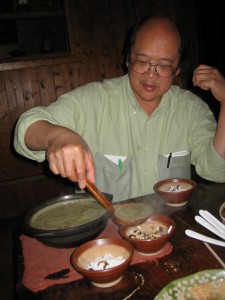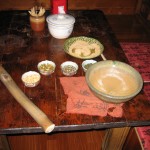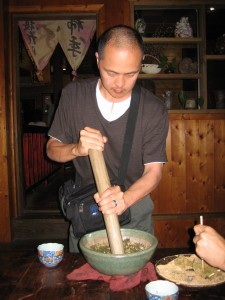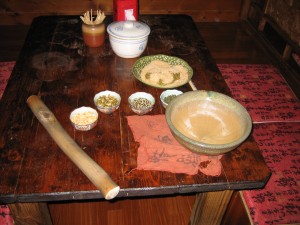
Ladle tea into bowls, add sweet condiments and puffed rice to taste.
Have you ever tasted lui cha (Hakka) or lei cha (Mandarin), also called pounded tea or thunder tea? Recently there was a post on a Facebook group site about this Hakka specialty. Someone had bought an instant mix for Hakka pestle cereal in an Asian supermarket and wondered what it was. I, too, have seen these packets and tried them, wondering if they were similar to the Hakka pounded tea I tasted in Taiwan. The instant version has a similar color and texture but the flavor seems a bit bland. In my recipe for a homemade version, you can taste the tea, smoothed by the richness of the nuts and seeds.
This beverage is is not like regular tea. In Taiwan, lui cha is made by pounding tea leaves, nuts, and seeds in a mortar and pestle, then blending with boiling water to make a thick, creamy beverage.

To make lui cha, pound tea leaves, nuts, and seeds.
There are a couple of stories about the origin of this tea. Almost two thousand years ago, as a general prepared to capture Chengdu, his troops were felled by a plague. A Hakka doctor prescribed this unique tea. The soldiers were miraculously cured. Another story claims centuries ago on the mainland, when the Hakka migrated south to Fujian, Jiangxi, and Guangdong provinces, they couldn’t carry much. But tea was light, quenched their thirst, and when they added ingredients from the local area, it filled their stomachs. So the tea gained a reputation for being healthy and filling.
In 1989 in Taiwan, the Beipu Agricultural Department was looking for a regional specialty to attract tourists and keep their Hakka village alive. They interviewed a Hakka woman who told them how to make lui cha. They asked if the tea could be sweetened. She replied that it probably would not hurt. So the sweet Taiwan version was born. Another version is savory, more about that in another post.
In my research for The Hakka Cookbook, I visited a Hakka tea house Kwang Fu Cha Fung in Beipu. I tasted their lui cha, a creamy slightly thick greenish-gray tea served with sweet condiments such as red dates, tapioca pearls, goji berries, and red beans in a syrup to balance the tea tannins. Spoonfuls of puffed rice are also added.

My brother tries to pound tea, nuts, and seeds to make a paste. It’s hard work.
The chef demonstrated how to make it, placing dried tea leaves, seeds, and nuts in a large rough textured bowl and pounding the ingredients with a big stick. Then he gave us a turn at pounding the tea. You need muscles to do this. After our pitiful attempts of pounding the mixture, one of his puny assistants took over and like a human food processor, turned the tea-nut-seed mixture into an oily paste in seconds. He stirred boiling water into the paste, then ladled the steaming tea into small bowls. We spooned the sweet condiments and puffed rice into our bowls. With the tea, we nibbled morsels of mochi-like pounded sweet rice dusted with ground peanuts. It was a delicious and unique Hakka tea ceremony.
In essence, this nutritious tea is basically a health drink. With a blender, it is rather easy to make and far superior in taste to the instant packets from Taiwan. The sweet condiments take more time to make. If you just want a simple health drink, make just the tea portion and skip the condiments in syrup. Instead just add some dried fruit like raisins, goji berries, candied ginger, or even sugar to add a bit of sweetness and balance the tea tannins. You can even save any leftover tea, cover and chill, then reheat a cup in the microwave for a quick pick-me-up for the next day.
Beipu Pounded Tea
This is an abbreviated and simplified version from the Pounded Tea with Sweets recipe on page 101 of The Hakka Cookbook.
Makes 6 to 8 servings
1/2 cup pumpkin seeds
3 tablespoons raw or roasted peanuts
2 tablespoons pine nuts
1 tablespoon chopped walnuts
1/4 cup white sesame seeds
1 tablespoon black or more white sesame seeds
2 tablespoons dried green tea leaves
3 cups boiling water
Sweet condiments: raisins, goji berries, chopped crystallized ginger, or raw sugar, to taste
Puffed rice cereal, to taste (optional)
1. In a 10-inch frying pan over low heat, stir the pumpkin seeds, peanuts, pine nuts, and walnuts until the nuts begin to lightly brown, 2 to 4 minutes. Add the white and black sesame seeds and stir until white sesame seeds turn golden, 1 to 2 minutes longer. Cool about 5 minutes.
2. In a blender, combine the tea and nut mixture. Whirl until finely ground. Add 1 cup of the boiling water. With a potholder firmly holding down the blender lid, blend on low speed, then increase to high and whirl until smooth. Pour the mixture into a 2- to 3-quart pan. Pour another 1 cup boiling water into the blender jar, whirl to remove any remaining residue, and add to pan. Pour remaining boiing water into the pan. Stir over low heat until hot and thick, 2 to 4 minutes. Ladle tea into cups or small bowls. Add sweet condiments and puffed rice to taste.




